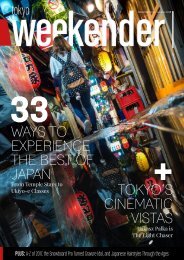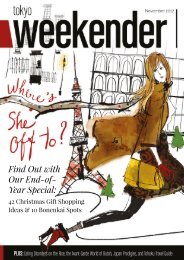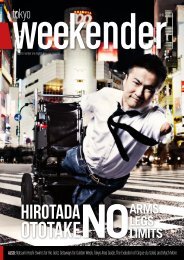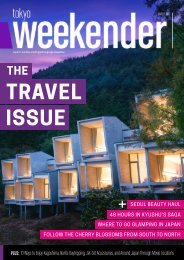Tokyo Weekender July 2016
Breaking the rules of kimono – a new book shatters antiquated views of this traditional garment. Plus: The boys for sale in Shinjuku Ni-chome, best sake of 2017, Japan's new emperor, and what really goes on inside "Terrace House."
Breaking the rules of kimono – a new book shatters antiquated views of this traditional garment. Plus: The boys for sale in Shinjuku Ni-chome, best sake of 2017, Japan's new emperor, and what really goes on inside "Terrace House."
You also want an ePaper? Increase the reach of your titles
YUMPU automatically turns print PDFs into web optimized ePapers that Google loves.
TRAVEL<br />
[ PROMOTION ]<br />
Explore Niigata<br />
with a New Market<br />
in <strong>Tokyo</strong>, and Four<br />
Local Festivals<br />
Niigata is an often overlooked prefecture home to Fuji Rock,<br />
great skiing slopes, and the Kodo drum group, but there's<br />
so much more. A new market offers a taste of the region's<br />
specialties right here in <strong>Tokyo</strong> this summer, with other<br />
regions to be showcased later in the year<br />
Summer is synonymous with<br />
festivals in Japan, and this month<br />
we’ve got our sights set on some of<br />
Niigata’s top matsuri. While many<br />
of us would love to throw caution to<br />
the wind and travel up and down the nation to<br />
experience these wonderful events firsthand,<br />
we know it’s not always easy to find the time.<br />
Thankfully you can also get your rural festival<br />
fix right here in the city at Tabisuru Shintora<br />
Market, a new ongoing event outside Toranomon<br />
Hills that opened earlier this year to promote<br />
local regions from across the nation. The<br />
current theme, named Summer Breeze, begins<br />
this month and features five cities from Niigata<br />
touting their wares and local specialties.<br />
But first, a closer look at the festivals and other<br />
attractions they’re famous for….<br />
FOR SAKE ENTHUSIASTS<br />
MURAKAMI CITY<br />
THE FESTIVAL This historical castle town<br />
is home to the Murakami Grand Festival, a<br />
traditional event that dates back over 380<br />
years and features large floats called oshagiri<br />
as the main draw. <strong>July</strong> 6-7, www.sake3.com/<br />
murakamitaisai<br />
WHILE YOU'RE THERE Located on Niigata’s<br />
coast, this city's claim to local fame is sake,<br />
sake and sake. (That’s salmon, sake and<br />
empathy for the rest of us.) Visitors are welcomed<br />
to long lanes of black wooden walls<br />
and fences – a signature Edo-period style –<br />
and rows of whole salmon hanging to air dry<br />
in the sun. The city also a slew of beautiful<br />
beaches and onsen, the most famous being<br />
Senami Onsen, which overlooks the ocean.<br />
HOW TO GET THERE Take the Joetsu Shinkansen<br />
to Niigata City, then switch to the<br />
Uetsu Honsen Line for Murakami Station.<br />
FOR TRADITIONAL CRAFT LOVERS<br />
SANJO AND TSUBAME<br />
THE FESTIVAL Known collectively as Sanjo-Tsubame, this world-class metalworking region<br />
is revered for its high-quality knives, and flatware used at the Nobel Prize banquet. The<br />
Tsubame-Sanjo Factory Festival allows visitors to have a rare chance to see skilled craftsmen<br />
as they work, and also join them for a drink at organized receptions. October 5-8, kouba-fes.jp<br />
WHILE YOU'RE THERE Hard physical work requires filling food, so it's no surprise Sanjo and<br />
Tsubame are famous for their curry ramen and seabura (back fat) ramen respectively. Echigo<br />
Miso Jyouzo lets visitors can try making their own batch of this traditional condiment.<br />
HOW TO GET THERE Take the Joetsu Shinkansen to Tsubame-Sanjo station.<br />
44 | JULY 2017 | TOKYO WEEKENDER
















